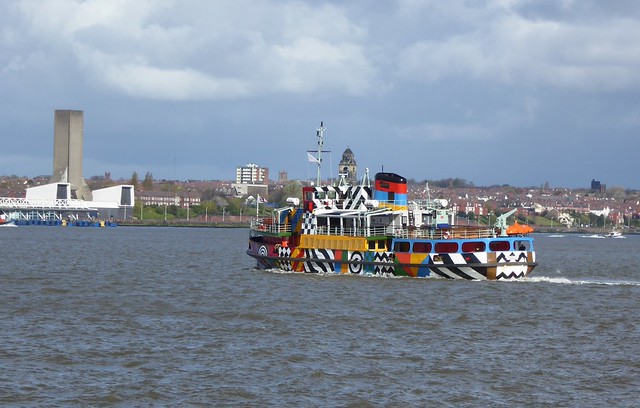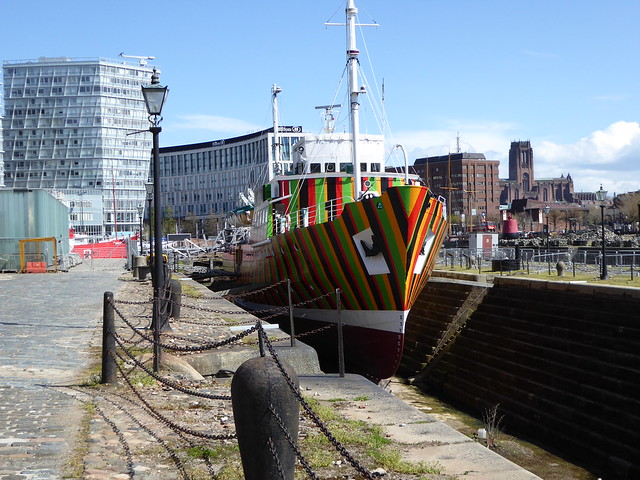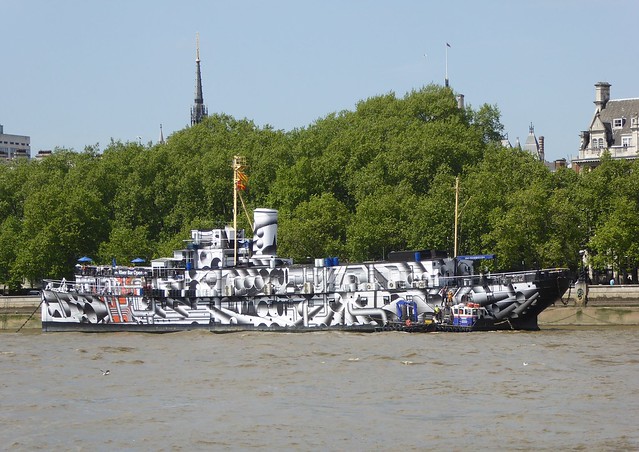Here is the Mersey ferry 'Snowdrop' crossing the river heading for Seacombe and decked out in Dazzle, or to be more precise it is called "Everybody Razzle Dazzle" and the design is by Sir Peter Blake, a pioneer of pop art with a impish sense of humour. I imagine he enjoyed this project. I'm rather fond of his collages, of which the most famous is the cover of the Beatle's
Sergeant Peppers Lonely Heart Club Band album.
The Dazzle project was part of the Liverpool biennial but also to mark World War One which was when the artist Norman Wilkinson (1878-1971) came up with this idea to protect naval ships. Unlike normal camouflage whose objective is to hide, this camouflage's idea was to mislead by making it difficult to estimate speed and bearing. Every ship design was different, for the full dazzling differences feast your eyes
here (HMS Argus is confusing enough on a photo goodness only knows what it looked like on the high seas). The connection with Liverpool is that the Dazzle ships of WW1 were mostly painted there. When not serving in the navy and inventing Dazzle Norman Wilkinson was a fine maritime painter. My first introduction to his work was the LMS railways travel posters of the 1920s and 1930s, today highly collectable items but for those without deep pockets available on postcards. I could have gone with a Liverpool view but as a contrast show a scene nearer in distance to where I live, a dazzling day of
gentle sailing on Windermere.
Time to return to the Liverpool waterfront and the pilot ship Edmund Gardner in Canning Dry Dock with its Dazzle stripes. Unfortunately all the area was padlocked and barricaded off so this was the best angle I could get, although the following day I did take some pictures from the rain splattered windows of the Maritime Museum, none of them very good, but the next photo at least shows more of the stripes
The Dazzle is by the artist Carlos Cruz-Diez (Induction Chromatique à Double Fréquence pour l'Edmund Gardner Ship, Liverpool, Paris 2014).
Lastly to complete the trio of Dazzle ships here is one I had no difficulty photographing from every angle because it was moored near Blackfriars Bridge in London and I merrily clicked my way along both banks of the Thames.
This is HMS President one of the three present day surviving Royal Naval ships of World War One (its date of 1918 may be a clue to one of the reasons it survived). This time the artist is Tobias Rehberger. When I took this photograph in May it was due to be officially 'launched ' in June so I wonder if the men at the front by the tug were putting some finishing touches or cleaning it.
Here is the ship's stern giving a closer view of the design and taken from the Victoria Embankment where she is moored.
All three ships were part of the
"14-18-NOW" WW1 Centenary Arts Commission.
An entry to ABC Wednesday, a journey through the alphabet, this week moored at D
here





